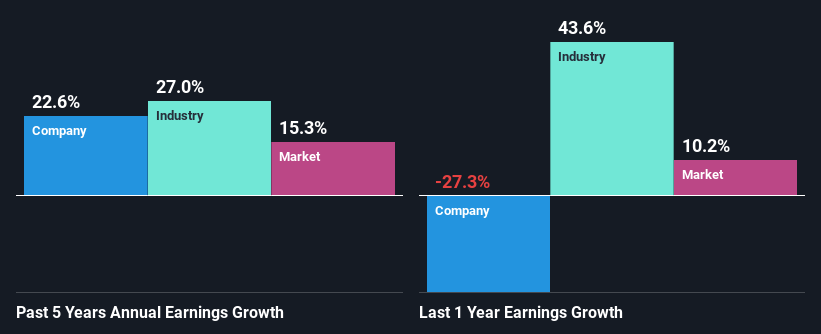Are Robust Financials Driving The Recent Rally In NVIDIA Corporation's (NASDAQ:NVDA) Stock?
NVIDIA's (NASDAQ:NVDA) stock is up by a considerable 25% over the past month. Since the market usually pay for a company’s long-term fundamentals, we decided to study the company’s key performance indicators to see if they could be influencing the market. Particularly, we will be paying attention to NVIDIA's ROE today.
Return on equity or ROE is a key measure used to assess how efficiently a company's management is utilizing the company's capital. In short, ROE shows the profit each dollar generates with respect to its shareholder investments.
View our latest analysis for NVIDIA
How To Calculate Return On Equity?
The formula for return on equity is:
Return on Equity = Net Profit (from continuing operations) ÷ Shareholders' Equity
So, based on the above formula, the ROE for NVIDIA is:
28% = US$6.0b ÷ US$21b (Based on the trailing twelve months to October 2022).
The 'return' is the amount earned after tax over the last twelve months. That means that for every $1 worth of shareholders' equity, the company generated $0.28 in profit.
What Has ROE Got To Do With Earnings Growth?
Thus far, we have learned that ROE measures how efficiently a company is generating its profits. Based on how much of its profits the company chooses to reinvest or "retain", we are then able to evaluate a company's future ability to generate profits. Assuming everything else remains unchanged, the higher the ROE and profit retention, the higher the growth rate of a company compared to companies that don't necessarily bear these characteristics.
NVIDIA's Earnings Growth And 28% ROE
First thing first, we like that NVIDIA has an impressive ROE. Second, a comparison with the average ROE reported by the industry of 19% also doesn't go unnoticed by us. Under the circumstances, NVIDIA's considerable five year net income growth of 23% was to be expected.
Next, on comparing NVIDIA's net income growth with the industry, we found that the company's reported growth is similar to the industry average growth rate of 27% in the same period.
Earnings growth is a huge factor in stock valuation. It’s important for an investor to know whether the market has priced in the company's expected earnings growth (or decline). Doing so will help them establish if the stock's future looks promising or ominous. If you're wondering about NVIDIA's's valuation, check out this gauge of its price-to-earnings ratio, as compared to its industry.
Is NVIDIA Using Its Retained Earnings Effectively?
NVIDIA has a really low three-year median payout ratio of 7.1%, meaning that it has the remaining 93% left over to reinvest into its business. This suggests that the management is reinvesting most of the profits to grow the business as evidenced by the growth seen by the company.
Besides, NVIDIA has been paying dividends for at least ten years or more. This shows that the company is committed to sharing profits with its shareholders. Existing analyst estimates suggest that the company's future payout ratio is expected to drop to 3.4% over the next three years. As a result, the expected drop in NVIDIA's payout ratio explains the anticipated rise in the company's future ROE to 63%, over the same period.
Conclusion
Overall, we are quite pleased with NVIDIA's performance. Particularly, we like that the company is reinvesting heavily into its business, and at a high rate of return. Unsurprisingly, this has led to an impressive earnings growth. Having said that, looking at the current analyst estimates, we found that the company's earnings are expected to gain momentum. To know more about the company's future earnings growth forecasts take a look at this free report on analyst forecasts for the company to find out more.
Have feedback on this article? Concerned about the content? Get in touch with us directly. Alternatively, email editorial-team (at) simplywallst.com.
This article by Simply Wall St is general in nature. We provide commentary based on historical data and analyst forecasts only using an unbiased methodology and our articles are not intended to be financial advice. It does not constitute a recommendation to buy or sell any stock, and does not take account of your objectives, or your financial situation. We aim to bring you long-term focused analysis driven by fundamental data. Note that our analysis may not factor in the latest price-sensitive company announcements or qualitative material. Simply Wall St has no position in any stocks mentioned.
Join A Paid User Research Session
You’ll receive a US$30 Amazon Gift card for 1 hour of your time while helping us build better investing tools for the individual investors like yourself. Sign up here

 Yahoo Finance
Yahoo Finance 
